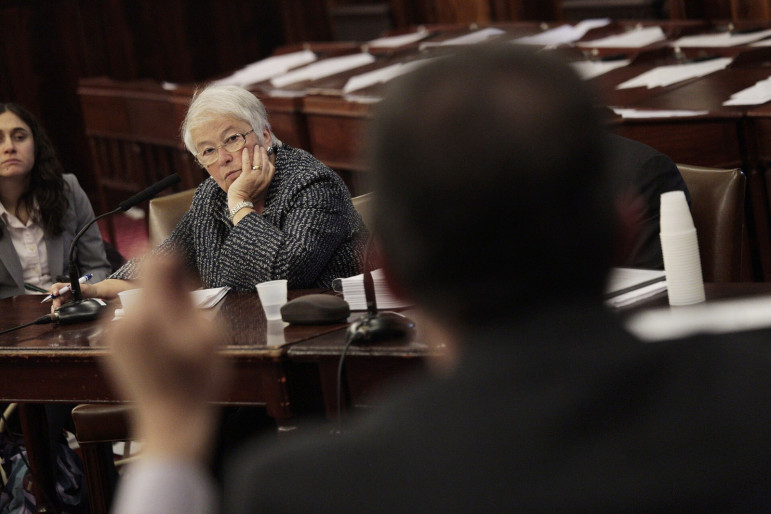
William Alatriste for the City Council
New York City Schools Chancellor Carmen Farińa at a City Council hearing. One year after Councilmembers grilled the DOE on their approach to special ed, there are signs of progress, advocates say.
One year after parents, advocates and members of the City Council’s education committee took the NYC Department of Education officials to task over the spectacularly poor graduation rates of children in special education, the city has been inching towards a solution, turning Staten Island, where 24 percent of students have IEPs (individualized education plans) into a kind of laboratory of improvement.
For the past month, interim acting Superintendent Anthony Lodico has been meeting with community groups in the borough to listen to ways the DOE can improve its services. Lodico, who taught for 18 years at Port Richmond High School before taking on other DOE posts, was this past month appointed superintendent of all the schools on Staten Island, from elementary to high school, a job that comes with no shortage of headaches – or challenges.
Of the almost 62,000 students on Staten Island, approximately 15,000 have an IEP.
Last fall, at a public hearing in City Hall in October, City Council Education Committee Chairman Daniel Dromm took the DOE to task for a host of problems with the city’s special education instruction – from the high percentages of minority students in special education classes to the length of time it takes for the DOE to respond to parents’ requests for services. Across the city’s 1,700 schools, approximately 132,700 children have an IEP; and the number of minority students with IEPs is startlingly high: four out of five students with an IEP are either Latino or black and two out of three are boys—ratios that are out of step with the city’s overall student population, which is 68 percent black or Latino and about half male.
While DOE officials acknowledged the high percentage of minority and immigrant children in special education classes, they stressed that the DOE had been making changes, creating a separate unit to address the needs of English language learners and rolling back the number of children assigned an IEP and placed in special-education classes.
For Andrea Lella, the founder of the autism support group Families Helping Families, the biggest change this current administration has wrought is its willingness to meet with parents and ask them what they need.
“‘What are you suing about that we can fix’,” Lella recalls Lodico asking her, bluntly, at a meeting with her on Staten Island last month. Lella, a mother of three children with disabilities, all graduates of Staten Island’s public schools, had her suggestions ready: Stop pulling children out of class for IEP services. Provide group services at the start or the end of the day so children don’t miss key instruction time. Increase the number of paraprofessionals in the classroom for younger children and hire DOE employees to provide the extra services children need, rather than giving out vouchers for expensive, inconveniently located private providers.
Lella says that when former Mayor Michael Bloomberg initiated the first of his three major reorganizations of the school system, the changes so significantly reduced the powers of the superintendents that there was little parents could do if their local principal refused to listen to their concerns. Under the current system, parents have a chain of command to target.
“It was a very positive meeting,” said Lella, of her August exchange with Lodico.
While the communication lines are open, the immediate prospects for deep reform are few: Lella says Lodico told her that any lasting reform was at least a year away.
But some changes have begun incrementally. This past July, schools Chancellor Carmen Farina announced the creation of seven Borough Field Support Centers to replace the 55 nonprofit networks Bloomberg created to support the schools. With an estimated staff of 700, the BFSCs will provide “integrated” support to the schools across all areas of instruction, according to the DOE, including operations, finance, human resources as well as support for English language learners and students with disabilities.
The DOE has said the field offices will be physically more accessible to superintendents and principals they support. Under the previous regime, support offices were sometimes in boroughs separate from the schools and school districts they supported.
In response to questions about his meeting with Lella, Lodico said he had been spending the past weeks meeting with community groups, advocates and families to hear their biggest concerns as well as meeting with principals of all the borough’s schools as well. His biggest push, he stressed, was to make sure that all the administrators, not just those in special education, understand they have a role to play in the IEP process.
“Readiness for high school starts in pre-k; How are we measuring that?” said Lodico, who referred to himself as the “ratings officer for principals.” The DOE talks a lot about college readiness and career readiness, he acknowledged, but special education needs to be part of the conversation if those longer-term goals are to be part of IEP kids’ reality. “The work we are doing now is really ensuring that our school leaders and our educators, whether they are special education or general education, really understand and own the IEP process – right now.”








